By Lambert Strether of Corrente.
Patient readers, I’m sorry this is late. Our server problems really threw me for a loop.
I had hoped to take a quick romp through the wonderful world of peat, but as it turns out, peat is complex in every way: By its nature in the biosphere, in its classification, in its modes of destruction. So I am afraid my post on this fascinating substance — which turns out to be the most efficient means of carbon capture on the planet — will not be exhaustive. First, I’ll look at the various definitions of peat. Then I will look at just one or two of the variegated ways we have to classify it, and present a world map of where peat is to be found (more places than you would think). Next, I will look at peat and carbon (capture, and release). Finally, I’ll look at what international organizations are doing to protect peat (not enough), and what you can personally do. (I will not be looking at industrial uses of peat, as fuel for example, because the idea of drying peat out for burning, “responsibly produced” or not, makes me crazy.)
But first, a picture showing the beauty of peat:
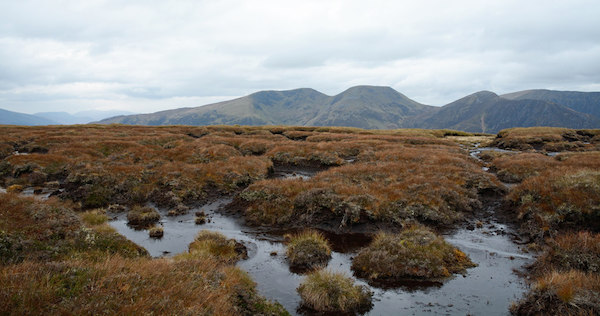
(© Copyright Trevor Littlewood and licensed for reuse under this Creative Commons Licence.) I think part of peat’s problem in this modern world is public relations: It’s not eye-catching, like the mountains in the background to which the eye is drawn. And although this video shows peat’s carbon and water storage capabilities vividly, still, a peat bog is not something you want to step in:
And here is a picture of Indonesian peatland after being despoiled by the palm oil industry:
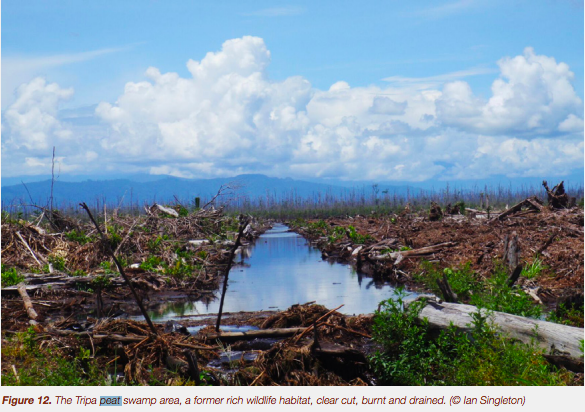
So, what is peat?
Peat Defined
There is, it turns out, an International Peatland Society (IPS). Here is their definition:
Peat is the surface organic layer of a soil that consists of partially decomposed organic matter, derived mostly from plant material, which has accumulated under conditions of waterlogging, oxygen deficiency, high acidity and nutrient deficiency.
(Bog acids and tannins preserve the famous bog mummies, through a process similar to pickling.) However, the IPS immediately begins backtracking:
In temperate, boreal and sub-arctic regions, where low temperatures (below freezing for long periods during the winter) reduce the rate of decomposition, peat is formed mainly from bryophytes (mostly sphagnum mosses), herbs, shrubs and small trees.
In the lowland humid tropics, peat is derived mostly from rain forest trees (leaves, branches, trunks and roots) under near constant annual high temperatures.
In other geographical regions peat can be formed from other species of plants that are able to grow in water-saturated conditions. For example, in New Zealand peat is formed from members of the Restionaceae while in tropical coastal fringes peat is formed in mangrove. New types of peat may still be found.
And they complete the backtracking process:
Definitions of peat vary across disciplines and between authorities for different purposes and there is no universal agreement that is applicable in all circumstances. This is unfortunate because it affects estimates of the area of peatland and determination of important attributes of peat, especially volume and carbon content.
So here we have peat’s public relations problem again: You can raise money for a trophy animal; everybody knows what a polar bear is. But how do you raise money for a squishy, mire-y entity — there is, apparently, controversy as to whether bogs and mires are the same, or not — that can’t be defined? More to the point, how do you get global stakeholders to defend the indefinable, let alone fund efforts to study and preserve it?[1]
As a sidebar, a particularly attractive aspect of peat bogs is that they create the conditions for their own reproduction. From (sorry) Wikipedia:
The characteristics of some bog plants actively promote bog formation. For example, sphagnum mosses actively secrete tannins, which preserve organic material. Sphagnum also have special water retaining cells, known as hyaline cells, which can release water ensuring the bogland remains constantly wet which helps promote peat production.
If I interpret the IPS correctly, sphagnum occurs in “temperate, boreal and sub-arctic” bogs, so it would be interesting to know if other plants in other parts of the world have a similar effect; I would imagine so.
Peat Classified
With even peat’s NGO unwilling to define it, it should come as no surprise that peat is also hard to classify. The Food and Agriculture Organization of the United Nations (FAO), in “Nature and Management of Tropical Peat Soils,” has drily hilarious summary:
The classification of peats and organic soils poses many problems…. Existing classification systems are based on:
i. Topography and geomorphology.
ii. Surface vegetation.
iii. Chemical properties of the peat.
iv. Botanical origin of the peat.
v. Physical characteristics of the peat.
vi. Genetic processes within the peatswamp.
“Existing classification systems” is very much plural; every one of the buckets contains multiple classification systems! Of all of these, I’ll pick out a sample from “iv. Botanical origin of the peat,” because that gives insight into peat formation:
The botanical origins of peat features highly in several classification systems. Frequent reference is made in the literature to Sphagnum peat which is extensive in temperate and tundra regions. It occurs also in the tropics at high altitudes, for example, in Rwanda/Burundi. Peats can be divided into major vegetation types such as moss peat, sedge peat, heath, saw-grass peat, Cyperacea peat and forest or woody peats. One of the problems of this type of classification is that peat deposits are often characterized by vertical sequences or layers of peat of different vegetative origin, each layer indicating a specific stage in the development of the deposit…. An understanding of the botanical composition of peat is valuable because many of the other characteristics of peat are related to it. For example, peats developed from reeds, sedges and various trees are generally two to four times richer in nitrogen than those from Sphagnum mosses and Eriophorum sedges (Lucas 1982). Lignin content is likewise often related to botanical origin. Woody peats generally contain low contents of cellulose and hemicellulose and large amounts of lignin. Since cellulose and hemicellulose decompose easily and lignin is the resistant fraction, the proportion of the latter increases as the peat decomposes, particularly in woody peats…. The wood content is also significant when considering the economic feasibility of reclamation and potential use.
(I like “reclamation.” From whom was the peat bog reclaimed, pray tell?) The layering and the lignin might be thought to point us in the direction of coal, and so it does. From Geology.com, “What is Coal?” we find that peat is the lowest rank of coal, where “rank progression corresponds to their level of organic metamorphism”:
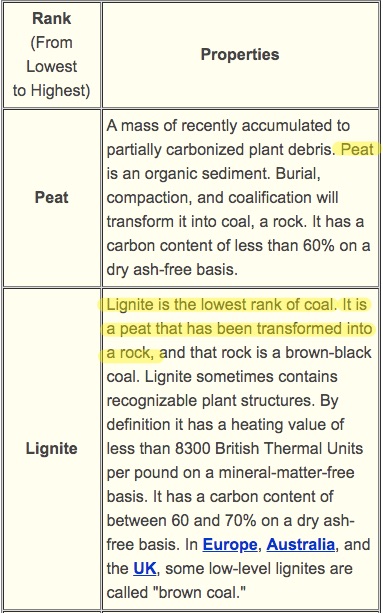
(You can see that on a geological time-scale, burning peat is the equivalent of eating our seed-corn.) Since peat, compressed and heated over time, becomes coal, you might think that peat bogs are really, really good at carbon capture, and you would be right! But before going there, let’s take a quick look at how widely peat is distributed throughout the world.
Peat Worldwide
Since peat hard to classify and even to define, mapping peat worldwide is not an easy task. However, the PEATMAP project has tried. From Catena, “PEATMAP: Refining estimates of global peatland distribution based on a meta-analysis,” we have description of the mapping process:
[T]he spatial extent of peatlands is poorly constrained. We report the development of an improved global peatland map, PEATMAP, based on a meta-analysis of geospatial information collated from a variety of sources at global, regional and national levels. We estimate total global peatland area to be 4.23 million km2, approximately 2.84% of the world land area. Our results suggest that previous global peatland inventories are likely to underestimate peat extent in the tropics, and to overestimate it in parts of mid- and high-latitudes of the Northern Hemisphere. Global wetland and soil datasets are poorly suited to estimating peatland distribution. For instance, tropical peatland extents are overestimated by Global Lakes and Wetlands Database – Level 3 (GLWD-3) due to the lack of ground-truthing data; and underestimated by the use of histosols to represent peatlands in the Harmonized World Soil Database (HWSD) v1.2, as large areas of swamp forest peat in the humid tropics are omitted.
Here is their map, the best we have:
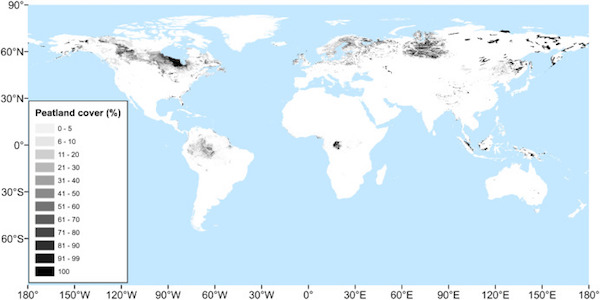
As you can see, peatlands are widely distributed.
Peat and Climate Change
From the Guardian, “Ultimate bogs: how saving peatlands could help save the planet“:
Peatlands are the superheroes of ecosystems: purifying water, sometimes mitigating flooding and providing a home for rare species. And they beat nearly every system when it comes to carbon storage. Known peatlands only cover about 3% of the world’s land surface, but store at least twice as much carbon as all of Earth’s standing forests. In addition, at least one-third of the world’s organic soil carbon, which plays a vital role in mitigating climate change and stabilizing the carbon cycle, is in peatlands.
“From a climate perspective, [peatlands] are the most essential terrestrial ecosystem,” says Tim Christophersen, a senior program officer with Forests and Climate at the United Nations Environment Programme.
Unlike rainforests or coral reefs, peatlands have largely been ignored by researchers and policymakers, to the extent that we don’t even know where all of the world’s peatlands are.
Once again, poor public relations. And the mapping project above. More:
Scientists used to believe that the vast majority of the world’s peatlands were in boreal and temperate areas, such as Minnesota, but we now know that the tropics are also home to huge areas of peatlands.
Early in 2017, scientists announced they had discovered the world’s largest tropical peatland in the Congo. The massive peatland – covering an area larger than New York State – stores as much carbon as is emitted from burning fossil fuels globally in three years, about 30bn metric tonnes.
“Many countries still do not know if they have peatlands,” Christophersen says.
A study published this year in Global Change Biology estimates that tropical peatlands – the most important in terms of carbon storage – may cover three times more land than previously estimated. But they are difficult to find because not all wetlands contain peat. The only way to know for sure is to send researchers to sample the soil, and that takes money.
Well, yes. Focusing on carbon alone, it’s clear that if peatlands capture enormous amounts of carbon, burning and despoiling them must release enormous amounts of carbon. And such is the case. Naturally, peat being peat, there are problems. From the Leeds Ecosystem, Atmosphere & Forest (LEAF) Centre, “The health burden of fires across Equatorial Asia“:
Peat fire emissions are challenging for scientists to model as they occur close to the ground, making it difficult for satellites to detect the depth of the burn.
Nevertheless, one attempt has been made for fire. From Climate News Network, “Peat bog fires are burning issue in climate calculations“:
Once started, peat fires are hard to stop. Fire in the treetops can race across the forest at 10 kilometres an hour, while smouldering peat can take a week to travel half a metre. But both can happen at once, the scientists report. “The tropical peatlands of South-east Asia are a clear demonstration of how human activity can alter the natural relationships between ecosystems and fire,” said Susan Page, professor of physical geography at the University of Leicester, UK, and a co-author of the latest report. In a Nature study in 2002, she calculated that a dramatic and sustained forest fire in Indonesia in 1997 may have sent 2.5 billion tonnes of carbon into the atmosphere – a figure that could have added up to 40% of all the emissions from all the fossil fuel burning that year. “Tropical peatlands are highly resistant to natural fires, but in recent decades humans have drained peatlands for plantation agriculture,” she said. “People cause the deep layers of peat to dry out, and also greatly increase the number of fire ignitions. It’s a double threat.”
(Here is a horrid example of Indonesian peatlands drained and burned for palm oil production.) A second study, showing carbon release from both draining and fire, from Science Direct, “A new methodology for organic soils in national greenhouse gas inventories: Data synthesis, derivation and application“:
Globally, drained peatlands and peat fires emit about 1 Gt carbon dioxide (CO2)-equivalents per year which corresponds to 10% of the greenhouse gas (GHG) emissions from agriculture, land-use change and forestry (Smith et al., 2014). … Drained peatlands rank among the largest GHG sources from agriculture and forestry in many European and Asian countries, even when they cover only a small percentage of the national area (Tubiello et al., 2016, Drösler et al., 2008). To achieve implementation of the goals given by the Paris Agreement, reducing emissions from drained peatlands is urgently required. The current “4 per mille” initiative aims to increase carbon stocks in soils as a compensation for anthropogenic GHG emissions (Minasny et al., 2017). However, the protection of the large carbon stocks in natural peatlands and the reduction of emissions from drained organic soils by rewetting is direly needed to not counterbalance any potential success in the management of mineral soils.
Peat and International Organizations
With peatlands being an ecosystem of such importance, we’d expect serious international efforts to preserve them. This does not appear to be happening. Turning to the IPS, we look at their strategic plan, excerpting from “Strategic Goal 3: To improve governance of peatlands through involvement with International Conventions,” and pulling out the “measurable objectives”:
The IPS will establish (by date) a mechanism to stimulate and monitor the provision of information to and contacts with policy makers and will solicit regular feedback from policy makers.
The IPS will continue to participate at relevant international events and through the provision of joint position papers with appropriate partners. It will provide members and stakeholders with information on the work of international organisations and conventions relevant to peatlands and peat, and with reports on IPS attendance at meetings of these bodies.
So, information sharing and conference attendance improve the governance of peatlands. Perhaps. I don’t know the NGOs and government agencies that govern? regulate? nudge? cajole? climate change issues, but it’s not clear to me that the IPS does either. So I decided to see if the World Economic Forum, in its Great Reset project, was even aware of peat. Sadly, no.
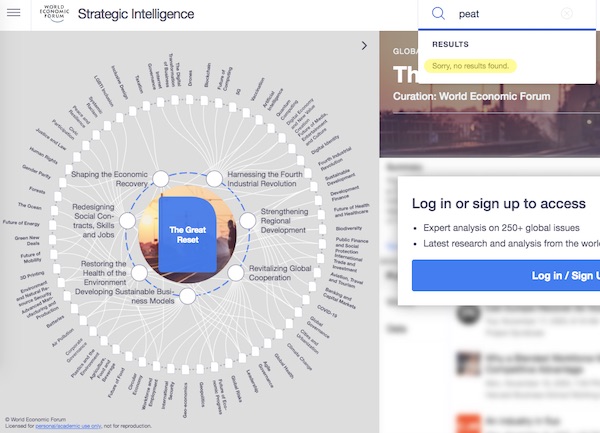
I also ran a search. Again, no.
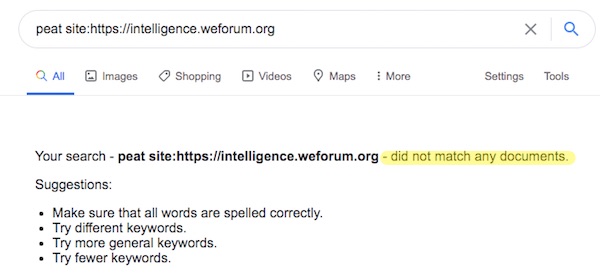
So, if any international organization is actively defending peatlands — as opposed to sharing information about them and going to conferences — I am not aware of it. I would be very happy to be educated on this point by readers!
What You Can Do
There are things you can do. One obvious action is to destroy the market for peat-based compost by refusing to buy it, urging others not to, and preventing home and garden shops from carrying it. From Gardens Illustrated:
The carbon content in peat is enormous. When you dig out peat and allow it to oxidise, all the carbon dioxide is released into the atmosphere, which contributes to global warming.
Surprisingly, it is gardeners, not commercial growers, that use most peat compost. The main reason is that there are millions of gardeners and they tend to use big pots and window boxes, so the volume of compost needed is very high, whereas commercial growers tend to raise young plants in small pots.
A second thing you can do is oppose “reclamation” of peatlands in your own jurisdiction, as you might a pipeline or a landfill. For example:
Scotland To The Rescue – Again
World heritage status for Scottish peat bogs could help UK hit net zero goals – the Flow Country, an expanse of almost uninterrupted blanket bog that stretches over about 4,000 sq km of Caithness and Sutherland – larger than Hampshire or Kent! pic.twitter.com/wQZs5j1AnV
— Grouse Beater (@Grouse_Beater) November 13, 2020
And, fancifully, since the World Heritage legal framework exists, why not aggressively seek to protect peatlands where found by proposing World Heritage status for them?
NOTES
[1] As readers know, I’m a little leery of the concept of “ecosystem services” because it strikes me as next door to commodification. Do all peat bogs provide the same “ecosystem services” or not?


thanks for this Lambert. I will send it to my school’s science specialist and we will see what we can do to increase the number of peat protectors.
> peat protectors
What a good idea!
On the subject of campaigning organisations, the Irish Peatland Conservation Council has been active for many years (mostly, it should be said, in education, not in active campaigning), but their work feeds into various direct campaigning groups. A lot of this comes from Ireland having had some of the finest lowland temperate peat bogs in the world. I say ‘had’, because most of them have been mined out for fuel and garden compost. Some, it should be said, are regenerating naturally.
A further point about peat is that much of the destruction happened in medieval times and later. The dry heaths of England were mostly peatlands that were extracted in their entirety by peasants. The pottery boom in the 16th Century netherlands was mostly fueled by peat – this extraction caused flooding which largely led to the famed large scale dykes of that country, which in turn destroyed much of the remaining peat.
Much open upland peat in western Europe appeared to have developed due to a mixture of deforestation and a wetting of the climate in the third millennium BC. In an area of Mayo not far from where the ancestors of Biden left, you can see an entire network of neolithic fields exposed when the peat was cut away.
A major enemy of upland peat is overgrazing by sheep – mostly due to bad agriculture policy (its rarely if ever profitable without public subsidy). One of the best things to happen to Irish upland peat bogs was the foot and mouth outbreak back in 2002 which led to the culling of most sheep. The recovery of many uplands area has been gratifyingly quick. But climate change could stop this quickly, as it is dependant on a climate of steady damp rain, not the downpours predicted.
The other big enemy of upland peat is conifer plantation (although its disputed as to how much damage this does – I’ve seen peat recover very rapidly after wood harvesting), and wind farms, although most of the problems with the latter are now largely fixed through better design and regulation.
One big question mark is whether the vogue for rewilding could have an unexpected negative impact on peat. Much of it has arisen from human intervention (deforestation mostly). Its possible that proposals to reforest wild areas could lead to the peatland drying out, producing more CO2 than the forests absorb. Nothing in this is simple or straightforward.
> wind farms, although most of the problems with the latter are now largely fixed through better design and regulation.
I didn’t get to this horrid story from the Daily Mail, “Amazing moment trees on hillside slide down slope after peat slippage on windfarm in Ireland.” Yes, there are videos!
I think a lot of the problem is the usual real estate speculators, as with California fires. “Bogs” are seen as “waste land, ” unproductive, when from every aspect but profit they are extraordinarily productive.
Yes, the Derrybrien collapse was notorious – it was an early scheme which has wound its way through the courts in Ireland for years. Essentially, it wasn’t appreciated at the time just how unstable upland blanket bog can be. It was thought at the time that it was cutting into bog that could lead to instability, but its now known that its actual additional weight that can lead to slippage. In the case of Derrybrien, it wasn’t cutting access roads that was the problem, it was the contractors storing cut peat on top of existing peat. Even quite experienced engineers get this wrong (I know a Civil Engineer who has made quite a career from educating other engineers on how not to get things wrong with peat).
Upland peat slippages are actually quite common and are a natural phenomenon – left by itself peat on upland slopes will continue to grow mass until eventually gravity wins. But of course humans make things worse with badly thought out interventions.
The good news about wind farms is that thanks to Derrybrien and other disasters, developers and regulators are much better at addressing the issues and minimising damage (although they still do cause a lot of peat loss, although a lot less than conifer plantations, the real enemy of peat in Britain and Ireland). And changes in the wind industry are leading away from upland areas anyway – the latest generation of turbines are designed for lowlands and off-shore. There are actually proposals in Ireland to re-flood lowland former peat bogs to allow them to regrow, with wind turbines constructed within the new flood lands. In Ireland there are vast areas of mined lowland peat (raised bogs, as distinct from upland blanket bog), and they are continually trying to find alternative uses for them. Just look at google map satellite view of Ireland – they are visible in the midlands as a rust-brown area – view in and you can see the drainage strips, the railways used to transport the peat, and the power stations built for peat (now mostly burning biomass).
Apologies, I posted that without looking at your link (I try to avoid giving the Daily Heil clicks). I thought it was the Derrybrien landslip from about 17 years ago, I didn’t realise it was a more recent one in Donegal.
Although that article highlights the wind farm, so far as I’m aware that slip was not directly connected to the wind farm – locals blamed it on forestry works, although its frequently the case that slippages are the result of an accumulation of factors. A common factor is illegal peat extraction by locals, although they are frequently inclined to blame someone else when the slip happens.
But as I said above, even engineers frequently attribute those slips to road cuttings when in fact there is little evidence that cuts destabilise peat – it is invariably weight (i.e. gravity) and drainage alterations that causes an unstable peat slope to break. Peat can slip on slopes of as little as 1%. The massive Derrybrien slippage was caused by a temporary peat stockpile built up by contractors as they were waiting for borrow pits to be finished.
Bravo, Lambert!
Though not a peat specialist myself, this soil scientist thanks you for this important educational effort. Peat needs all the help that it can get.
One of my favourite regular outings for students is to a peat bog at our school’s research forest. We had the summer crew make a boardwalk in from one edge so we can get out into the middle and walk around on the bog without needing gumboots. (The middle part is not nearly as squishy as the one in your video.)
I always enjoy showing them how to poke down through the deposit (about 2 m thick) with a special Russian peat auger, showing the transition in peat characteristics with depth. Then, finally, we hit the underlying glacial sediment which is a bluish-gray from having been in strongly anaerobic (oxygen-starved) conditions for thousands of years.
One thing to note in the global peat map above – it’s not just coincidental that the biggest extent of peat in the northern hemisphere runs through the mid-section of Canada, and at similar latitudes in Siberia. This roughly coincides with the southern limit of discontinuous permafrost – cold soils suppress decomposition so peat can build up. Eventually as you go farther north, peat is less likely to accumulate to the same extent because the growing season is too short, reducing plant biomass production. So there’s a climatically controlled balance.
> One thing to note in the global peat map above – it’s not just coincidental that the biggest extent of peat in the northern hemisphere runs through the mid-section of Canada, and at similar latitudes in Siberia. This roughly coincides with the southern limit of discontinuous permafrost – cold soils suppress decomposition so peat can build up. Eventually as you go farther north, peat is less likely to accumulate to the same extent because the growing season is too short, reducing plant biomass production. So there’s a climatically controlled balance.
Thank you, that’s excellent perspective.
I was going to comment on the decomposition angle as well. Here in NZ we’ve got a mix of cold-induced and acidity-induced peats, but in all cases I suspect it’s down to conditions that are hostile to a few key fungal detritovores.
Stuck in the AIR?? I didn’t know they could do that! Are they shoveling, or sprinkling sand, or anything/
Funny, this was entered as a reply in links, to a Wukchumni F-35 story.. How did it get to Peat: Superhero of the Biosphere?
Great topic! I’m a sort-of farmer having spent time working on various farming outfits and currently running a small urban youth farm and environmental center. One of the great living patriarchs of organic farming, Eliot Coleman, weighed into this topic stating that the sustainability of peat depends on what part of the world it came from. He classed Europe a historical over-harvester and home to dwindling supplies, and Canada a largely untapped resource that actively grows in size every year by a greater amount than is removed. Regardless of whether that is true however, I think the carbon sequestering aspect you point out certainly changes the weight of that argument…. it seems to be a bad idea harvesting any of it.
I have come across the idea of using shredded and decomposed leaves, called leaf mold as a substitute, but I have never seen it sold commercially. It is also possible to use 100% compost to start seeds, but not all compost is the same quality… and without any peat in the mix you can have problems with compaction and poor drainage. It is unfortunate that peat really is such a great ingredient with unique properties.
Interestingly, what gets marketed as the “better” alternative is the furry outer part of coconuts called coconut coir… which is a direct byproduct of the palm oil industry that is currently on an ecological rampage and even made an ironic appearance in this article! So you really cant win with commercial alternatives. Every year I buy big bags of seed starting mix and it is mostly made out of peat… just one of the many compromises I have to make given limited available options and the limits of time.
Modern growers can’t whine too much as there is of course a long history of farming before peat so lots of ways around it, but it means a lot needs to be unlearned. I certainly hope to figure out a way to eliminate peat from our growing system, but it is honestly hard to prioritize when there are so many other unsustainable elements built into the economics of small scale vegetable growing. So, I have to pick which thing to worry about at the moment.
> So you really cant win with commercial alternatives.
Perhaps there’s a lesson here for all of us.
I am not a composting expert; it’s too much like work. That said, on the theory of “let no organic matter leave the property,” leaf mulch would be the way to go (I got twenty or thirty garbage bags worth from two biggish trees). I wonder if there are people out there seeking to improve it.
I had the same reaction to coconut coir as Mr. Rogers – great it’s not a finite resource but waiiiiit a minute there.
However, for commercial uses it comes back to scale. Most commercial growers are using cubes an inch square for propagation or four inches square for growing fairly large plants, because more is waste. The coir component along with various sizes of rocks and sand (also finite and running out!) don’t really amount to much, even with the enormous churn that commercial growers have. And when I did some math, you could nix the entire palm oil industry and the use of coconuts for food would still generate plenty enough waste.
I hadn’t considered the profligate use of home gardeners though, maybe that breaks it.
Banana leaves I think might currently get processed into some interesting byproducts for this sort of use too?
We compost and it isn’t much more work than carrying out the garbage. A bucket under the sink and a bin out the back door to dump it in. Once a year, enough for a small garden and there are only two of us.
I understand adding earthworms speeds it up. Plan to try it.
Our township collects and composts it and will load up my dump truck for a couple of bucks. They have free wood chips too. I don’t quite trust it very much for vegetables because some of the leaves come from roadside ditches, but I know people who use it to mulch garlic and it seems to work very well.
As the teeming billions put ever more pressure on ever more every last bit of land, every bit of land which cannot be Made to PAY will be changed into some other form which CAN be MADE to PAY. If the Canada Sphagnum Moss lands can be sustainably harvested to sell peat moss to the world, that may be the only chance these lands have to avoid being drained and removed to mine whatever crappy tar sands or beautiful diamonds or wonderful gold might lie beNEATH them.
Lambert: ‘Focusing on carbon alone, it’s clear that if peatlands capture enormous amounts of carbon, burning and despoiling them must release enormous amounts of carbon.’
Indeed. And yet reading this piece, I didn’t see you use the ‘S word’ once.
Here it is. Siberia. Siberia. Siberia. Siberia.
Within the next decade — and maybe the next couple of years, God help us — you’re going to see a whole lot more attention on burning peatlands as anybody with two brain cells to rub together starts losing their s**t about what’s going on there. Because it looks like trigger time —
https://earthobservatory.nasa.gov/images/147083/another-intense-summer-of-fires-in-siberia
https://www.nature.com/articles/d41586-020-02568-y
> Here it is. Siberia. Siberia. Siberia. Siberia.
Quite right, thank you. Siberia is on the map supplied. I had intended to do some geographic case studies, but ran out of runway…
‘Permafrost in the Arctic can thaw faster than presumed’
https://phys.org/news/2020-05-permafrost-arctic-faster-presumed.html
https://www.sciencealert.com/another-giant-gaping-crater-was-suddenly-found-in-siberia-the-largest-in-recent-years
Potter Stewart on the definition of peat: “I know it when I see it.”
thanks for this insight into something critical. our atmosphere doesn’t need anymore Methane and Carbon–sorry for everyone but, imo, it’s a broken record we need to make peace with listening to.
my experience with seeing peat ‘bogs’ is limited to what i saw roadside driving the Dalton Hwy up to Deadhorse and upland Baltic Poland. Evidently the Boundry Waters up north have a good bit. Strange stuff to step off into indeed.
I have some familiarity with swamps and permanent wetlands down here that function similarly in their carbon sequestration:
from the Association of Wetlands Managers(who knew?)
https://www.aswm.org/wetland-science/wetlands-and-climate-change/carbon-sequestration
All types of wetlands are carbon sequestering systems (aka “carbon sinks”), from temperate freshwater wetlands to boreal peatlands. That means that wetlands have the ability to store excess carbon (via photosynthesis) from the atmosphere – one of the primary components of greenhouse gases and a driver of climate change. Drainage and degradation of wetlands can release significant amounts of this stored carbon back into the atmosphere in the form of methane and reduce the ability of wetlands to sequester additional carbon.
A very particular narrow subset of peatlands . . . the sphagnum bogland peatlands . . . are the source of garden peat-moss. My understanding is that garden peat-moss is dead sphagnum which still retains some sphagnum structure and has not yet been aged and compressed all the way into actual peat.
I know that some spokesfolks for the peat moss industry say that peat-moss harvesting can be a sustainable harvest rather than a one-time strip mining event. Allegedly, the peat moss bog lands in question are managed as a series of dike-able containable zones where water level may be drained and/or then restored. So it is drained and dried and the peat-moss ( not yet peat) dug up for processing and sale. And then that zone is reflooded and kept reflooded and the sphagnum allowed to grow back and begin building up dead pre-peat sphagnum.
If that is true, then sphagnum harvesting operations can be as sustainable as the dig-a-layer-and-wait-20 year terra preta “mines” in parts of Brazil . . . where the terra preta grows back its missing volume after some ( only some) of it is removed. And as carbon-neutral too.
IF! that is true. If it IS true, the peat-moss industry must get some valid truth-based science before the public before the entire public boycotts the peat-moss industry into extinction based on incomplete and biased Thunberg-science, the way the veganist militants have tried to exterminate the carbon-capture livestock-on-pasture sector based on biased Thunberg fake-science.
Here is an example of the biased fake-Thunberg type of science of which I speak . . .
On the reddit I just now see this article in the Guardian.
https://www.theguardian.com/commentisfree/2020/nov/18/laugh-if-you-want-but-the-mcplant-burger-is-a-step-to-a-greener-world
Some of it seems interesting. But then I get to this little paragraph . . . “Beef is a particular climate offender, requiring 28 times more land, six times more fertilizer, and 11 times more water to produce than other animal proteins like chicken or pork.” Is the author of that sentence an unfortunate victim of the confusion between feedlot corn-soy beef as against pasture-and-range grassenplants-eating beef? Or is this author a deliberate perpetrator and perpetuator of that confusion?
And how destructive will that kind of fake-science-based analysis be when applied to the “sphagnum bogland” sector?